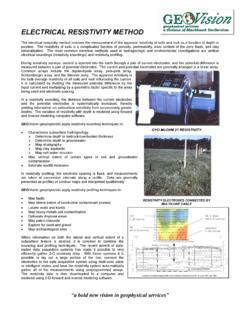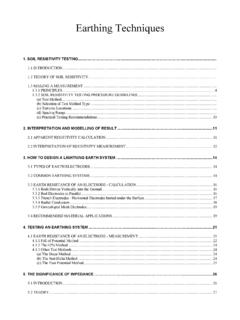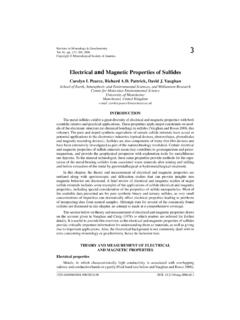Transcription of Electrical imaging surveys for environmental and ...
1 Electrical imaging surveys for environmental and engineering studies A practical guide to 2-D and 3-D surveys Copyright (1997, 1999, 2000) by Dr. (All rights reserved). Copyright (1999) ii Copyright and disclaimer notice The author, , retains the copyright to this set of notes. Users may print a copy of the notes, but may not alter the contents in any way. The copyright notices must be retained. For public distribution, prior approval by the author is required. It is hoped that the information provided will prove useful for those carrying out 2-D. and 3-D field surveys , but the author will not assume responsibility for any damage or loss caused by any errors in the information provided. If you find any errors, please inform me by email and I will make every effort to correct it in the next edition. October 2000. Copyright (1999) iii Table of Contents 1.
2 Introduction to resistivity surveys 1. Introduction 1. Traditional resistivity surveys 1. The relationship between geology and resistivity 3. 2. 2-D Electrical imaging surveys 5. Introduction 5. Field survey method - instrumentation and field procedure 5. Pseudosection data plotting method 8. Forward modeling program exercise 8. Advantages and disadvantages of the different arrays 10. Wenner array 11. Dipole-dipole array 14. Wenner-Schlumberger array 15. Pole-pole array 15. Pole-dipole array 17. High-resolution surveys with overlapping data levels 18. Summary 19. Computer interpretation 19. Data input and format 19. Guidelines for data inversion 20. Field examples 24. Agricultural pollution - Aarhus, Denmark 24. Odarslov dyke - Sweden 25. Underground cave - Texas, 25. Landslide - Cangkat Jering, Malaysia 27. Old tar works - 27.
3 Holes in clay layer - 27. Magusi River ore body - Canada 29. Marine underwater survey - 31. Time-lapse water infiltration survey - 31. Cross-borehole survey - 34. Wenner Gamma array survey - Nigeria. 35. Mobile underwater survey - Belgium. 36. 3. 3-D Electrical imaging surveys 38. Introduction to 3-D surveys 38. Array types for 3-D surveys 38. Pole-pole array 38. Pole-dipole array 40. Dipole-dipole array 40. Summary 40. 3-D roll-along techniques 41. 3-D forward modeling program 41. Data inversion 43. Examples of 3-D field surveys 46. Birmingham field test survey - 46. Septic tank survey - Texas 48. Sludge deposit - Sweden 48. Copyright (1999) iv Acknowledgments 51. References 52. Appendix A Data format for dipole-dipole, pole-dipole and Wenner-Schlumberger arrays. 54. Appendix B Topographic modelling 56. Appendix C Inversion method 58.
4 Appendix D Statistical data filtering 60. Copyright (1999) v List of Figures Figure Page Number 1. A conventional four electrode array to measure the subsurface resistivity . 1. 2. Common arrays used in resistivity surveys and their geometric factors. 2. 3. The three different models used in the interpretation of resistivity measurements. 3. 4. A typical 1-D model used in the interpretation of resistivity sounding data for the Wenner array. 4. 5. The arrangement of electrodes for a 2-D Electrical survey and the sequence of measurements used to build up a pseudosection. 6. 6. The use of the roll-along method to extend the area covered by a survey . 7. 7. The apparent resistivity pseudosections from 2-D imaging surveys with different arrays over a rectangular block. 9. 8. The sensitivity patterns for the (a) Wenner (b) Wenner-Schlumberger and (c) dipole-dipole arrays.
5 12. 9. Two different arrangements for a dipole-dipole array measurement with the same array length but with different a and n factors resulting in very different signal strengths. 14. 10. A comparison of the electrode arrangement and pseudosection data pattern for the Wenner and Wenner-Schlumberger arrays. 16. 11. The sensitivity pattern for the pole-pole array. 16. 12. The forward and reverse pole-dipole arrays. 17. 13. Example of inversion results using the smoothness-constrain and robust inversion model constrains. 21. 14. An example of a field data set with a few bad data points. 22. 15. Subdivision of the subsurface into rectangular blocks to interpret the data from a 2-D imaging survey using different algorithms. 24. 16. (a) The apparent resistivity pseudosection for the Grundfor Line 2 survey with (b) the interpretation model section.
6 25. 17. The observed apparent resistivity pseudosection for the Odarslov dyke survey together with an inversion model. 26. 18. The observed apparent resistivity pseudosection for the Sting Cave survey together with an inversion model. 26. 19. (a) The apparent resistivity pseudosection for a survey across a landslide in Cangkat Jering and (b) the interpretation model for the subsurface. 28. 20. (a) The apparent resistivity pseudosection from a survey over a derelict industrial site, and the (b) computer model for the subsurface. 28. 21. (a) Apparent resistivity pseudosection for the survey to map holes in the lower clay layer. (b) Inversion model and (c) sensitivity values of model blocks used by the inversion program. 29. 22. Magusi River ore body. (a) Apparent resistivity pseudosection, (b). resistivity model section, (c) apparent metal factor pseudosection and (d) metal factor model section.
7 30. 23. (a) The measured apparent resistivity pseudosection, (b) the calculated apparent resistivity pseudosection for the (c) model section from an underwater marine survey . 31. 24. (a) The apparent resistivity and (b) inversion model sections from the survey conducted at the beginning of the Birmingham infiltration study. 33. Copyright (1999) vi 25. Sections showing the change in the subsurface resistivity values with time obtained from the inversion of the data sets collected during the infiltration and recovery phases of the study. 33. 26. Model obtained from the inversion of data from a cross-borehole survey to map the flow of a saline tracer in between two boreholes. 34. 27. Bauchi Wenner Gamma array survey . (a). Apparent resistivity 35. pseudosection. (b) The inversion model with topography. Note the location of the borehole at the 175 metres mark.
8 28. (a) The apparent resistivity pseudosection for the first two kilometres of 36. an underwater survey along a riverbed by Sage Engineering, Belgium. (b) The inversion model after three iterations. 29. The arrangement of the electrodes for a 3-D survey . 39. 30. The location of potential electrodes corresponding to a single current electrode in the arrangement used by (a) a survey to measure the complete data set and (b) a cross-diagonal survey . 39. 31. Using the roll-along method to survey a 10 by 10 grid with a resistivity -meter system with 50 electrodes. 42. 32. (a) 3-D model with 4 rectangular blocks and a 15 by 15 survey grid. (b) Horizontal apparent resistivity psudosections for the pole-pole array with the electrodes aligned in the x- direction. 44. 33. The models used in 3-D inversion. 45. 34. Arrangement of electrodes in the Birmingham 3-D field survey .
9 46. 35. Horizontal and vertical cross-sections of the model obtained from the inversion of the Birmingham field survey data set. 47. 36. The model obtained from the inversion of the septic tank field survey data set. 49. 37. The 3-D model obtained from the inversion of the Lernacken Sludge deposit survey data set displayed as horizontal slices through the earth. 50. 38. The 3-D model obtained from the inversion of the Lernacken Sludge deposit survey data set displayed with the Slicer/Dicer program. 51. 39. Arrangement of the electrodes for the dipole-dipole, pole-dipole and Wenner-Schlumberger arrays, together with the definition of the "a". spacing and the "n" factor for each array. 55. 40. Inversion models for the Rathcroghan Mound data set. 57. 41. Error distribution bar chart from a trial inversion of the Grundfor Line 1 data set with 5 bad data points.
10 61. Copyright (1999) 1. 1 Introduction to resistivity surveys Introduction The purpose of Electrical surveys is to determine the subsurface resistivity distribution by making measurements on the ground surface. From these measurements, the true resistivity of the subsurface can be estimated. The ground resistivity is related to various geological parameters such as the mineral and fluid content, porosity and degree of water saturation in the rock. Electrical resistivity surveys have been used for many decades in hydrogeological, mining and geotechnical investigations. More recently, it has been used for environmental surveys . The resistivity measurements are normally made by injecting current into the ground through two current electrodes (C1 and C2 in Figure 1), and measuring the resulting voltage difference at two potential electrodes (P1 and P2).





